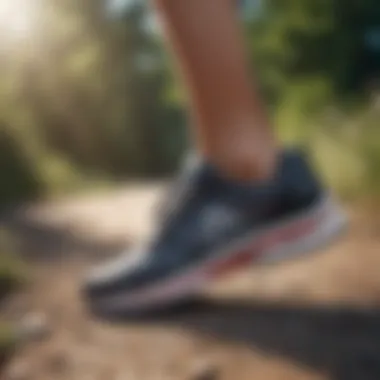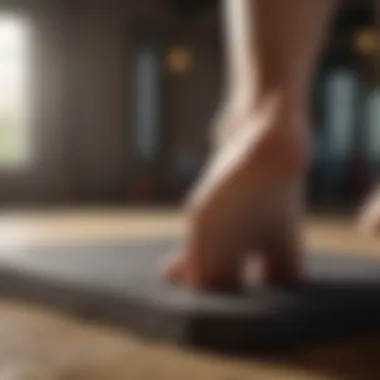Top Running Shoes with Arch Support for Flat Feet


Intro
Flat feet, or pes planus, occur when the arches of the feet collapse, leading to the entire sole making contact with the ground. This condition can cause discomfort and various foot-related problems during physical activities such as running. Selecting the right running shoes with adequate arch support is essential for individuals with flat feet to ensure proper alignment, reduce pain, and enhance performance.
In this article, we will examine the importance of arch support, explore specific features to look for in running shoes, and provide a curated list of the best models available on the market. Furthermore, insights from experts in the field will be included to help readers understand how proper footwear influences overall foot health and running experience.
Understanding Flat Feet
Understanding flat feet is crucial in the context of selecting the right running shoes for individuals who experience this condition. Flat feet refer to a condition where the arch of the foot is lower than normal or completely flat, creating several complications in movement and foot health. By comprehending this condition, one can better appreciate the necessity of proper arch support in running shoes.
Definition of Flat Feet
Flat feet, also known as fallen arches, occur when the arch of the foot does not form adequately, causing the entire sole to come into contact with the ground. This condition can be present from an early age, often caused by genetic factors or as part of the natural aging process. It can also develop due to other circumstances such as injury or excessive weightbearing activity. Understanding this definition is the first step in recognizing its implications for overall foot health.
Causes of Flat Feet
The causes of flat feet can be multifaceted. Common causes include:
- Genetics: A family history of flat feet can predispose individuals to this condition.
- Weak or Dysfunctional Tendons: The posterior tibial tendon plays a significant role in arch support. If this tendon is weak or injured, it can lead to flat feet.
- Aging: As people age, ligaments may lose strength and elasticity, diminishing the arch height.
- Obesity: Excess weight can put additional strain on the arches, contributing to their flattening.
- Injuries or Illnesses: Certain injuries to the foot or conditions like arthritis can also affect the functioning of the arches.
Common Symptoms Experienced
Individuals with flat feet may experience a range of symptoms, which can significantly affect their lifestyle and well-being. Some common symptoms include:
- Pain in the Feet or Ankles: This discomfort often arises due to overpronation and poor alignment of the feet.
- Swelling: Flat feet can lead to inflammation in various foot structures.
- Fatigue in the Feet and Legs: This fatigue can result from the extra effort required to stabilize the body during walking or running.
- Postural Changes: Flat feet may lead to issues in the knees, hips, and lower back due to altered gait.
Importance of Arch Support in Running Shoes
Arch support is a crucial aspect of running shoe design, especially for individuals with flat feet. Flat feet can lead to various biomechanical issues while running, which reinforces the necessity of well-structured footwear. When the arches of the feet collapse, the body's alignment is affected, resulting in increased strain on muscles and joints. The right arch support can mitigate these effects, making it essential for runners seeking both comfort and enhanced performance.
How Arch Support Affects Running
The arch of the foot plays a significant role in distributing weight during activities like running. With proper arch support, the foot can maintain its natural alignment, promoting efficient energy transfer from the ground into the body. In the absence of adequate support, flat feet may cause overpronation, where the foot rolls inward excessively. This leads to instability and can hinder running efficiency.
Additionally, arch support can assist runners by maintaining a correct running form. Those with flat feet often compensate by altering their gait, which can place additional stress on areas such as the knees and hips. Arch support counters these tendencies, allowing runners to focus on their performance rather than potential discomfort.
Impact on Comfort and Performance
Comfort is a paramount concern for any runner. Feet endure considerable stress with each stride, and inadequate arch support can exacerbate discomfort, especially for individuals with flat feet. A well-designed shoe that incorporates proper arch support reduces fatigue and enhances endurance. When runners feel comfortable, they can push their limits and improve their performance.
Moreover, shoes with solid arch support tend to enhance stability, which is needed for a successful running session. This stability is critical, as it encourages better form and more powerful strides. Runners equipped with such shoes report greater satisfaction during workouts, and they are more likely to maintain a consistent training regimen, leading to performance improvements over time.


Reducing Risk of Injury
Injury prevention is a primary concern for runners. The lack of arch support can lead to various injuries, including plantar fasciitis, shin splints, and Achilles tendonitis. These conditions are often a direct result of poor foot mechanics, common among flat-footed individuals.
"Proper arch support can significantly decrease the likelihood of common running injuries, allowing for a more sustainable exercise regime."
By incorporating arch support into running shoes, the biomechanics of the foot can be corrected. This not only distributes impact forces more evenly but also minimizes excessive motion that can lead to injuries. Consistent use of appropriate footwear encourages healthy running habits and aids in the long-term health of the feet.
Key Features to Look for in Running Shoes
When selecting running shoes, particularly for those with flat feet, it is vital to focus on specific features that can enhance performance and comfort. The right footwear can make a significant difference in a runner’s experience and overall foot health. Below are the key characteristics to consider.
Arch Support Level
Arch support is one of the most critical features for runners with flat feet. Flat feet lack the natural arch that aids in shock absorption and stability. Thus, choosing shoes with adequate arch support is essential. The correct arch level can help distribute weight evenly, reducing strain on the feet and lower limbs.
A good arch support structure helps maintain proper foot alignment during running. This alignment can improve your running posture and reduce the impact on joints. It is advisable to test different arch levels to find one that suits your personal comfort and running style.
Cushioning and Stability
Cushioning and stability are also paramount. Shoes should provide sufficient cushioning to absorb shock during impact. This buffer helps protect the joints, particularly for those running on hard surfaces. Look for shoes that have a balance between plush cushioning and firm support. This combination can help offer stability without sacrificing comfort.
Stability features, such as medial posts or a supportive heel counter, can help control foot motion. For runners with flat feet, a shoe with enhanced stability can provide better control and prevent overpronation, a common issue in individuals with flat feet.
Shoe Fit and Sizing
Proper fit and sizing cannot be overlooked. The shoes should not be too tight or too loose, as this can lead to blisters or undue pressure. When trying on shoes, it is advisable to wear the socks you normally use while running. Ensure there is adequate space in the toe box; your toes should have room to move without feeling cramped.
Brand sizing may also differ, so it is wise to check specific sizing guides for each manufacturer. If you have orthotics, ensure the shoes accommodate them comfortably. Finding the right fit can prevent injuries and promote a more comfortable running experience.
Material Quality and Breathability
The materials used in running shoes play a critical role in performance and comfort. Opting for high-quality materials can enhance durability and support. Look for shoes made from breathable materials, which help keep the feet cool and dry. This consideration significantly impacts longer runs, as excess heat can lead to discomfort.
Additionally, materials that wick moisture away can help prevent blisters. Pay attention to the shoe’s upper; a well-constructed upper ensures a secure fit while allowing for necessary flexibility.
Weight of the Shoe
Finally, the weight of the shoe is an important factor. Lighter shoes can provide speed but may sacrifice some support. Conversely, heavier shoes often offer more cushioning and support but can slow down the runner. As a rule of thumb, look for shoes that strike a balance between weight and support.
Choosing the right weight usually depends on your running style and distance. For longer runs, a slightly heavier shoe might provide the necessary support, while short and fast runs might benefit from a lighter design.


Finding the right running shoes tailored to your unique needs is an investment in your overall running experience.
Recommended Running Shoes for Flat Feet
Selecting the right running shoes is essential for individuals with flat feet. The choice of footwear affects comfort, performance, and overall foot health during running activities. In this section, we will explore various models tailored for flat-footed runners, emphasizing their unique features and benefits.
Top Models Overview
When considering the best running shoes for flat feet, several models stand out due to their design and technology. These shoes typically offer enhanced structure and support. Some noteworthy examples include:
- Asics Gel-Kayano: Renowned for its sturdy build and great cushioning. The Gel technology absorbs impact, reducing stress on flat arches.
- New Balance 860: This model excels in stability with its supportive midsole. It caters to runners needing extra control with every stride.
- Brooks Adrenaline GTS: A favorite among many, this shoe provides reliable support for flat arches. Its focus on comfort delivers a smooth running experience.
- Saucony Guide: It combines cushioning and stability. The shoes feature an integrated support system that adjusts as you run.
- Nike Air Zoom Structure: Known for its responsiveness, it incorporates innovative cushioning materials. This optimizes comfort while maintaining support for flat arches.
Comparative Analysis of Features
Now let's delve deeper into the specific features of these recommended models. Each shoe offers distinct advantages, impacting performance and comfort levels:
- Cushioning Technology: Models like the Asics Gel-Kayano and Brooks Adrenaline GTS feature gel and soft foam, which enhances shock absorption. This is vital for flat-footed runners as it mitigates strain on the feet.
- Arch Support Design: New Balance 860 incorporates a firm yet flexible arch support that helps prevent overpronation. This feature is particularly important for those with flat feet.
- Weight and Brethability: Certain shoes, such as the Saucony Guide, emphasize lightweight materials allowing for speed. Breathability is a key factor, as it keeps feet cool and dry, thus enhancing overall comfort.
- Stability Features: The Nike Air Zoom Structure effectively integrates stability features within its design. These elements work together to promote a natural gait cycle, essential for flat-footed runners.
Budget-Friendly Options
Affordability is an important consideration for many runners. Fortunately, several options do not compromise on quality yet remain budget-friendly:
- Nike Revolution: This shoe delivers a supportive fit with decent cushioning. It is a fine choice for casual runners looking for a good entry-level shoe.
- Adidas Duramo: Known for its lightweight design and sufficient support. This model accommodates flat feet at a reasonable price.
- Reebok Run Supreme: This offers a simple design with adequate cushioning. Its affordability makes it suitable for occasional runners.
High-End Models
For those willing to invest more into their running shoes, several high-end models provide exceptional support and technology:
- Hoka One One Bondi: This shoe is known for its maximal cushioning. It offers extraordinary comfort and support for long-distance runners.
- Altra Paradigm: A unique option that emphasizes a foot-shaped design and zero-drop platform, promoting a natural running style.
- On Cloudstratus: Combines innovative cushioning with responsive support. Its engineered mesh upper ensures a comfortable fit.
User Experiences and Reviews
User experiences and reviews are essential elements that provide real-world insights into products. They serve as a valuable resource for anyone looking to understand how specific running shoes perform under various conditions, especially for individuals with flat feet. This section highlights the unique perspective of those who have firsthand knowledge about these shoes, making it easier for potential buyers to make informed choices.
Feedback from Flat-Footed Runners
Flat-footed runners often share their experiences regarding the challenges they face while running. Many report discomfort and pain when using inadequate footwear. Feedback from this group tends to emphasize the influence of arch support on their overall running experience. Some key points that emerge from their reviews include:
- Comfort: Many runners appreciate shoes that provide solid arch support. Comfort is crucial, as inadequate support can worsen their condition.
- Performance: Runners frequently mention how good shoes help them enhance their performance. Improved stability can lead to increased confidence and reduced fatigue.
- Injury Prevention: Numerous accounts highlight how a suitable pair of shoes can mitigate the risk of injuries such as plantar fasciitis or shin splints, common issues for flat-footed individuals.
Runners also find that certain brands, known for their arch-supporting shoes, receive consistent praise. For example, brands like Brooks and ASICS often appear in positive reviews, with users noting significant improvements in their running experiences. This valuable feedback informs potential buyers about the brand’s effectiveness and fit.


Expert Opinions
Expert opinions contribute an additional layer of credibility to the discourse surrounding running shoes for flat feet. Professionals in sports medicine and podiatry provide critical guidance that merges clinical insights with practical advice. Here’s what experts typically emphasize:
- Foot Evaluation: Experts suggest that a proper evaluation of foot type is necessary. They explain that understanding one’s unique foot mechanics can significantly affect shoe choice.
- Importance of Arch Support: Professionals stress that effective arch support aids in aligning the body, enhancing running efficiency, and preventing unnecessary strain on muscles and ligaments.
- Recommendations: Many experts provide specific recommendations based on their experiences treating runners with flat feet, such as selecting shoes with both high cushioning and stability.
"Choosing the right running shoes is essential for flat-footed individuals. It's not just about comfort; it's about ensuring longevity in their running practice."
— Sports Medicine Specialist
Maintaining Foot Health
Maintaining proper foot health is vital for anyone, especially for individuals with flat feet. Flat feet can lead to various complications, such as pain in the arches, knees, and lower back. Therefore, understanding how to care for your feet can enhance comfort and longevity in an active lifestyle. If left unaddressed, poor foot health can result in more severe issues, making proactive measures even more essential.
Importance of Proper Footwear
Selecting the right footwear is crucial. Shoes with adequate arch support help to sustain feet and support proper alignment. This can alleviate pain that individuals with flat feet often encounter. Shoes should have a firm heel counter and cushioning for shock absorption. Wearing improper footwear may lead to additional stress on the feet, contributing to discomfort. The right shoes can provide the necessary stability and cushion during activities, reducing the risk of foot-related injuries. In addition, the design and materials of the shoes should cater to specific needs of flat-footed runners.
Warm-up and Stretching Techniques
Incorporating warm-up and stretching techniques is another fundamental component of maintaining foot health. Before a run, warm-up exercises increase blood flow to muscles, enhancing flexibility and readiness. Activities like toe raises, ankle circles, and gentle stretches targeting the calves and achilles can be beneficial. These practices can prepare the feet for the demands of running, helping to prevent injuries. Moreover, post-run stretching is equally important, as it promotes recovery and helps maintain muscle elasticity.
Regular Foot Assessments
Frequent foot assessments can also play a key role in foot health. Individuals should regularly check their feet for signs of stress or injury. These assessments can include evaluating the condition of the skin and nails as well as monitoring any pain levels during and after activities. It may also be helpful to consult a healthcare professional for routine check-ups. They can provide personalized advice based on a thorough examination. This proactive approach can ensure that any potential issues are addressed promptly, keeping runners healthy and able to perform efficiently.
Regularly assessing foot health helps to catch problems before they escalate into more serious conditions.
In summary, maintaining foot health is an ongoing commitment for runners with flat feet. Prioritizing proper footwear, engaging in appropriate warm-up and stretching techniques, and conducting regular assessments can lead to significant improvements in comfort and overall foot health.
Culmination
The conclusion serves as an essential element of this article as it weaves together the insights presented throughout. It reinforces the necessity of understanding the specific needs of flat-footed runners and highlights the crucial role that proper arch support plays in running shoes. Each point discussed earlier—from the causes of flat feet to the detailed examination of product features—underscores the importance of making educated choices when selecting footwear.
Summarizing Key Points
In summary, the following key points emerge from the discussion:
- Understanding Flat Feet: Flat feet can lead to various discomforts if not addressed properly with suitable footwear. Recognizing the symptoms and causes is paramount.
- Importance of Arch Support: Adequate arch support can drastically affect running performance and overall comfort, significantly reducing injury risks linked to poor foot mechanics.
- Key Features of Running Shoes: Factors such as arch support level, shoe fit, cushioning, material quality, and shoe weight are critical in ensuring optimal support for flat-footed runners.
- Recommendations and User Feedback: A curated selection of running shoes tailored for flat feet, along with user experiences and expert opinions, can guide informed decisions.
By compiling these insights, the article highlights that the right pair of shoes can lead to enhanced running experiences and improved foot health.
Encouragement for Informed Choices
Finally, it is vital for those affected by flat feet to understand their unique requirements. Making informed choices regarding running shoes can lead to significant improvements not only in comfort and performance but also in overall well-being. Consider the following recommendations:
- Seek Expert Guidance: If unsure about what shoes to choose, consulting with a specialist can provide tailored advice based on individual needs.
- Prioritize Fit: Always try on shoes and consider their fit over aesthetic appeal. Aim for a snug fit without excessive tightness.
- Experiment: It is worth trying different models to find the one that provides the best support and comfort.
By paying attention to these elements, individuals can ensure they choose the right footwear that aligns with their lifestyle, significantly impacting their running experience. This deliberate approach allows for better management of flat feet and promotes long-term foot health.















